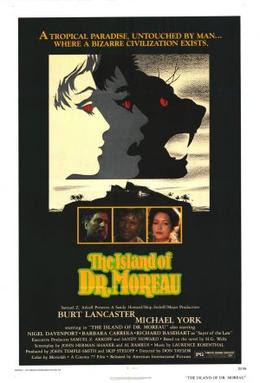 |
| Credit: Wikipedia |
As I said last post, I had to postpone our fourth Monday Book-To-Movie to this fifth Monday. In a Book-To-Movie (BTM), we review a work of prose fiction and its movie adaptation. In the previous BTM we reviewed H.G. Wells' science fiction horror classic, "The Island of Dr. Moreau" and its 1932 movie adaptation, "The Island of Lost Souls". Today we're going to look at American International Pictures’ (AIP) 1977 film that has the same title as the book. This version has the realism of the novel and the countercultural revolution of the early 1970s.
Synopsis of the Book
A short synopsis of Wells’ novel: A shipwrecked passenger takes refuge on a remote island and discovers that it is the place of exile of Dr. Moreau, a mad scientist who cruelly forces the evolutionary process in animals to make them human.
The 1977 Movie Adaptation
A Twist in Plot
AIP’s “Dr. Moreau” is basically faithful to the book but, as with “Lost Souls”, leaves out a lot of scenes from it. However, it contains some twists that work well. The main one of these is that, unlike in the novel or 1932 film, the doctor does one of his cruel experimentations on a major character, literally turning that character from human to beast.
Filming Style
Other major differences from the 1932 version are products of the film’s decade of release. Instead of stylistic filming like the original's film noir technique, this one's style is much more realistic which is reminiscent of the source material. It comes along with the 1970s' paradigm of cinematic realism.
An example of this (besides the absence of heavy light and shadow) is that, for the most part, Moreau's "House of Pain" looks like an ordinary Victorian structure rather than a strange, menacing one like in the original movie.
Hairy Beasts Suggesting 1970s Counterculture
The mob-like attack of the beast people suggests the protests of the early ‘70s’ counterculture. When the beast men rebel, it’s not over the debunking of their leader, Moreau, as God as it is in “Lost Souls”. Instead, it’s over his act of hypocrisy.
Moreau breaks the law that he tells the beast people that they, like all humans, have to live by, and it’s a capital offence. However, the hairy rebels don’t react by bearing peace picket signs like hippies did in the latter half of the 1960s. Instead, they launch a violent attack like what much of the counterculture of the early 1970s did.
After having seen "The Island of Lost Souls", even though I've always loved 1977's film version of Wells' "The Island of Dr. Moreau", I'm more of a stylist when it comes to film and so love the original film most. But being a fan of ‘70s pop culture, I can't love AIP's version that much less. However, the novel will always take precedence over these two films since only Wells has told the full story and has told it really good.
Smashwords’ Summer Sale
Don't forget, Smashwords' Summer/Winter Sale ends today! If you haven't taken advantage of the groovy markdowns on the thousands of authors' books during this sale, today's your last chance! These markdowns include my own books that's prices have been reduced by 50% and 100%!
Upcoming Book of Short Fiction
On Friday, I finished another round of revisions on a story for my upcoming short fiction collection, "Bad Apps". This book will consist of tales about strange and deadly mobile device apps. To find out more details about "Bad Apps" and its work-in-progress, subscribe to my free newsletter, "Night Creatures' Call". I'm currently getting together a new edition of the newsletter and am hoping to get it out in the next week or so.
Be here Wednesday for another Insecure Writer's Support Group blog hop! Have you seen 1977's "The Island of Dr. Moreau" or read H.G. Wells' novel that it’s based on? Have you been to the Smashwords Summer/Winter Sale and, if so, found anything interesting?
Until next time . . .
I vaguely remember reading the novel and I've seen all three movie versions of it. Curious how you think the third film held up to the book.
ReplyDeleteI haven't seen the third film yet; that's the one I plan on watching next and doing a review of here. Both of the previous films stuck to the basic plot, at least I thought, but a lot of changes were made and some new characters added.
DeleteI remember the 1977 version as a bit creepy. I've never read the book though.
ReplyDeleteThe 1977 version had some intense scenes, but the book had scenes that were even more disturbing.
Delete